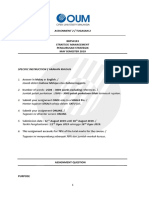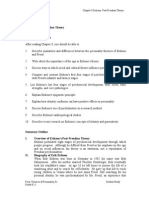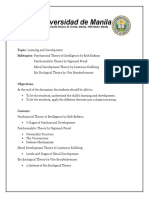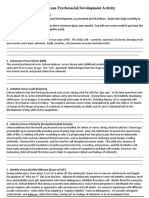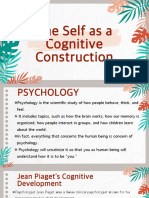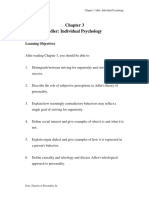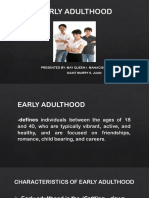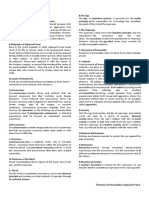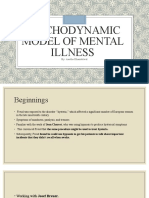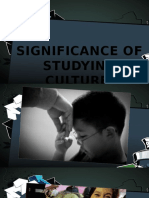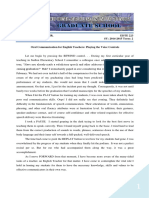9 - Erikson - Post-Freudian Theory
9 - Erikson - Post-Freudian Theory
Uploaded by
stephanieCopyright:
Available Formats
9 - Erikson - Post-Freudian Theory
9 - Erikson - Post-Freudian Theory
Uploaded by
stephanieOriginal Description:
Copyright
Available Formats
Share this document
Did you find this document useful?
Is this content inappropriate?
Copyright:
Available Formats
9 - Erikson - Post-Freudian Theory
9 - Erikson - Post-Freudian Theory
Uploaded by
stephanieCopyright:
Available Formats
Erik Erikson: Post-Freudian Theory who do not develop hope retreat from the world, and
this withdrawal is the core pathology of infancy.
Summary Outline
B. Early Childhood
I.Overview of Erikson's Post-Freudian Theory The 2nd to 3rd year of life is early childhood, a period that
Erikson postulated eight stages of psychosocial development compares to Freud's anal stage, but it also includes mastery of
through which people progress. Although he differed from other body functions such as walking, urinating, and
Freud in his emphasis on the ego and on social influences, his holding. The psychosexual mode of early childhood is anal-
theory is an extension, not a repudiation of Freudian urethral-muscular, and children of this age behave both
psychoanalysis. impulsively and compulsively. The psychosocial crisis of early
childhood is autonomy versus shame and doubt. The
II.Biography of Erik Erikson psychosocial crisis between autonomy on the one hand and
When Erik Erikson was born in Germany in 1902 his name was shame and doubt on the other produces will, the basic
Erik Salomonsen. After his mother married Theodor strength of early childhood. The core pathology of early
Homberger, Erik eventually took his stepfather's name. At age childhood is compulsion.
18 he left home to pursue the life of a wandering artist and to
search for self-identity. He gave up that life to teach young C. Play Age
children in Vienna where he met Anna Freud. Still searching From about the 3rd to the 5th year, children experience the
for his personal identity, he was psychoanalyzed by Ms. Freud, play age, a period that parallels Freud's phallic phase. Unlike
an experience that allowed him to become a psychoanalyst. In Freud, however, Erikson saw the Oedipus complex as an early
mid-life, Erik Homberger moved to the United States, changed model of lifelong playfulness and a drama played out in
his name to Erikson, and took a position at the Harvard children's minds as they attempt to understand the basic facts
Medical School. Later, he taught at Yale, the University of of life. The primary psychosexual mode of the play age
California at Berkeley, and several other universities. He died is genital-locomotor, meaning that children have both an
in 1994, a month short of his 92nd birthday. interest in genital activity and an increasing ability to move
around. The psychosocial crisis of the play age is initiative
III.The Ego in Post-Freudian Psychology versus guilt. The conflict between initiative and guilt helps
One of Erikson's chief contributions to personality theory was children to act with purpose and to set goals. But if children
his emphasis on ego rather than id functions. According to have too little purpose, they develop inhibition, the core
Erikson, the ego is the center of personality and is responsible pathology of the play age.
for a unified sense of self. It consists of three interrelated
facets: the body ego, the ego ideal, and ego identity. D. School Age
The period from about 6 to 12 or 13 years of age is called
A. Society's Influence the school age, a time of psychosexual latency, but it is also a
The ego develops within a given society and is influenced by time of psychosocial growth beyond the family. Because
child-rearing practices and other cultural customs. All cultures sexual development is latent during the school age, children
and nations develop a pseudospecies, or a fictional notion can use their energies to learn the customs of their culture,
that they are superior to other cultures. including both formal and informal education. The
psychosocial crisis of this age is industry versus
B. Epigenetic Principle inferiority. Children need to learn to work hard, but they also
The ego develops according to the epigenetic principle; that is, must develop some sense of inferiority. From the conflict of
it grows according to a genetically established rate and in a industry and inferiority emerges competence, the basic
fixed sequence. strength of school age. A lack of industry leads to inertia, the
core pathology of this stage.
IV.Stages of Psychosocial Development
Each of the eight stages of development is marked by a conflict E.Adolescence
between a syntonic(harmonious) element and Adolescence begins with puberty and is marked by a person's
a dystonic (disruptive) element, which produces a basic struggle to find ego identity. It is a time of psychosexual
strength or ego quality. Also, from adolescence on, each stage growth, but it is also a period of psychosocial latency. The
is characterized by an identity crisis or turning point, which psychosexual mode of adolescence is puberty or genital
may produce either adaptive or maladaptive adjustment. maturation. The psychosocial crisis of adolescence is identity
versus identity confusion. Psychologically healthy individuals
A. Infancy emerge from adolescence with a sense of who they are and
Erikson's view of infancy (the 1st year of life) was similar to what they believe; but some identity confusion is normal. The
Freud's concept of the oral stage, except that Erikson conflict between identity and identity confusion
expanded the notion of incorporation beyond the mouth to produces fidelity, or faith in some ideological view of the
include sense organs such as the eyes and ears. The future. Lack of belief in one's own selfhood results
psychosexual mode of infancy is oral-sensory, which is in rolerepudiation, or an inability to bring together one's
characterized by both receiving and accepting. The psycho- various self-images.
social crisis of infancy is basic trust versus basic
mistrust. From the crisis between basic trust and basic
mistrust emerges hope, the basic strength of infancy. Infants
Theories of Personality: Erik Erikson
F.Young Adulthood A. Generativity and Parenting
Young adulthood begins with the acquisition of intimacy at Dan McAdams and colleagues have developed the Loyola
about age 18 and ends with the development Generativity Scale (LGS) to measure generativity and to
of generativity at about age 30. The psychosexual mode of conduct research on this concept. Researchers have used the
young adulthood is genitality, which is expressed as mutual LGS to investigate the impact of parental generativity on the
trust between partners in a stable sexual relationship. Its development of children. Bill Peterson (2006) tested his
psychosocial crisis is intimacy versus isolation. Intimacy is the prediction that parents with high generativity should produce
ability to fuse one's identity with that of another without fear happy, well-adjusted offspring. His results were supportive of
of losing it; whereas isolation is the fear of losing one's identity the general notion that having a sense of generativity is
in an intimate relationship. The crisis between intimacy and important to effective parenting. Not only did children of
isolation results in the capacity to love. The core pathology of highly generative parents have more self-confidence, a
young adulthood is exclusivity, or inability to love. stronger sense of freedom, and more general happiness with
life; they also had a stronger future time orientation (Peterson,
G.Adulthood 2006).
The period from about 31 to 60 years of age is adulthood, a
time when people make significant contributions to society. B. Generativity vs. Stagnation
The psychosexual mode of adulthood is procreativity, or the Erikson generally considered stagnation and generativity to be
caring for one's children, the children of others, and the opposite ends of the same continuum, so that an individual
material products of one's society. The psychosocial crisis of who is high on generativity tends to be low on stagnationand
adulthood is generativity versus stagnation, and the vice versa. But recently researchers have been exploring
successful resolution of this crisis results in care. Erikson saw stagnation and generativity as somewhat independent
care as taking care of the persons and products that one has constructs. Van Hiel and colleagues, again using the LGS,
learned to care for. The core pathology of adulthood found that generativity and stagnation can operate
is rejectivity, or the rejection of certain individuals or groups separately in adults. In addition, they found that when
that one is unwilling to take care of. measured separately, stagnation is related to problems in
emotional regulation, while generativity is not. Moreover,
H.Old Age they discovered that some people measure high on both
The final stage of development is old age, from about age 60 generativity and stagnation, and that such a personality profile
until death. The psychosexual mode of old age isgeneralized is not mentally or emotionally healthy, as it includes difficulties
sensuality; that is, taking pleasure in a variety of sensations both with emotional regulation and with intimacy (van Hiel,
and an appreciation of the traditional life style of people of the Mervielde, De Fruyt, 2006). In that this research preserves
other gender. The psychosocial crisis of old age is the struggle Erikson’s two constructs of generativity and stagnation, it is
between integrity (the maintenance of ego-identity) not a big departure from Erikson; however, it does show that
and despair (the surrender of hope). The struggle between these two constructs can, and sometimes do, function
integrity and despair may produce wisdom (the basic strength independently in adult development.
of old age), but it may also lead to disdain (a core pathology
marked by feelings of being finished or helpless). VII.Critique of Erikson
Although Erikson's work is a logical extension of Freud's
V.Erikson's Methods of Investigation psychoanalysis, it offers a new way of looking at human
Erikson relied mostly on anthropology and psychohistory to development. As a useful theory, it rates high on its ability to
explain and describe human personality. generate research, about average on its ability to be falsified,
to organize knowledge, and to guide the practitioner. It rates
A.Anthropological Studies high on internal consistency and about average on parsimony.
Erikson's two most important anthropological studies were of
the Sioux of South Dakota and the Yurok tribe of northern VIII.Concept of Humanity
California. Both studies demonstrated his notion that culture Erikson saw humans as basically social animals who have
and history help shape personality. limited free choice and who are motivated by past
experiences, which may be either conscious or
B.Psychohistory unconscious. In addition, Erikson is rated high on both
Erikson combined the methods of psychoanalysis and optimism and uniqueness of individuals.
historical research to study several personalities, most notably
Gandhi and Luther. In both cases, the central figure
experienced an identity crisis that produced a basic strength
rather than a core pathology.
VI.Related Research
Erikson's theory has generated a moderately large body of
research, much of it investigating the concepts of identity and
generativity. In this section, the authors focused on
(1) generativity and parentingand (2) generativity vs.
stagnation.
Theories of Personality: Erik Erikson
Multiple Choice
_____11.The psychosocial crisis of early childhood is
_____1.Throughout his adult life, Erik Erikson identified with a.basic trust versus basic mistrust.
____, a nation where he lived for only a few months of his b.intimacy versus isolation.
life. c.industry versus inferiority.
a.Germany b.The United States d.autonomy versus shame and doubt.
c.The United Kingdom d.Norway e.compromise versus cooperation.
e.Denmark
_____12.Erikson's early childhood stage corresponds with
_____2.In contrast to Freud, Erikson which of Freud's stages?
a.placed more emphasis on unconscious motivation. a.oral b.anal c.phallic d.genital e.oedipal
b.placed more emphasis on the ego.
c.de-emphasized social and historical influences on _____13.According to Erikson, ____ is a feeling of self-
personality. consciousness and of being looked at or exposed.
d.all of these. a.shame b.guilt c.doubt d.threat e.exhibitionism
______3.Erikson built on Freud's theory by ___14.To Erikson the original model for human playfulness is
a.elevating social factors over biological ones. a.the mother-child bond. b.the Oedipus complex.
b.emphasizing the id as the key to personality development. c.thumb-sucking. d.basic mistrust.
c.accepting Jung's idea of a collective unconscious. e.basic trust.
d.none of these.
e.all of these. _____15.The basic strength of the play age is _____.
a.fidelity b.purpose
______4.According to Erikson, which of these is the most c.care d.autonomy
important aspect of the ego? e.playfulness
a.self-conscious ego b.perceived ego
c.ego identity d.realistic ego _____16.Will is the basic strength of
a.infancy. b.early childhood.
_____5.During childhood, Erikson said, the ego c.the play age. d.adolescence.
a.develops from the superego.b.is weak and flexible.
c.is dormant. d.does not exist. _____17.Heidi is beginning to make new friends of her
age. For the first time in her life, she has developed a
______6.To Erikson, the ego develops relationship with adults who are not in her family. Heidi is in
a.within a social structure. which of Erikson's stages?
b.independent of historical factors. a.early childhood b.adolescence
c.most rapidly during adulthood. c.infancy d.genital period
d.only after the id stops developing. e.school age
______7.Some societies hold that they are special and _____18.The genital-locomotor psychosexual mode marks
somehow more important than other societies. Erikson this stage.
referred to this belief as a.infancy b.play age
a.an ethnocentric imperative.b.a Napoleonic complex. c.adolescence d.young adulthood
c.a narcissistic illusion. d.pseudospecies. e.early childhood
______8.Erikson believed that healthy development rests on _____19.The psychosocial crisis of the school age is
a.a conflict between syntonic and dystonic tendencies. a.autonomy verses shame and doubt.
b.a conflict between masculine and feminine elements. b.trust versus mistrust.
c.an unresolved Oedipus complex. c.identity versus identity confusion.
d.a resolved Oedipus complex. d.industry versus inferiority.
e.a strong superego.
_____20.Generalized sensuality characterizes the
______9.The epigenetic principle states that psychosexual stage of ______.
a.some societies believe themselves to be special. a.adolescence b.young adulthood
b.the ego develops from the dying id. c.adulthood d.old age
c.the ego develops in a sequence, with each stage emerging e.preadolescence
from and being built on a previous stage.
d.central to individual development are those traits and Answer Key
tendencies inherited from our ancestral past. 1.e 6.a 11.d 16.b
2.b 7.d 12.b 17.b
_____10.Erikson believed that ___ is the basic strength of 3.a 8.a 13.a 18.b
infancy 4.c 9.c 14.b 19.b
a.hope b.faith c.will d.love e.industry 5.b 10.a 15.b 20.d
Theories of Personality: Erik Erikson
You might also like
- Erikson Childhood and Society PDFDocument2 pagesErikson Childhood and Society PDFPaula0% (5)
- The Life Cycle Completed by Erikson, Erik HomburgerErikson, Joan MowatDocument119 pagesThe Life Cycle Completed by Erikson, Erik HomburgerErikson, Joan MowatKrisztian IndriesNo ratings yet
- Guiding School Improvement With Action ResearchDocument8 pagesGuiding School Improvement With Action Researchrgk2060100% (1)
- Connect To Coreect (Edited Final)Document98 pagesConnect To Coreect (Edited Final)The Intentional Parent Academy100% (1)
- Chapter 7 Emotional DevelopmentDocument27 pagesChapter 7 Emotional DevelopmentAbegail RuizNo ratings yet
- Karen HorneyDocument28 pagesKaren HorneyShara May AcostaNo ratings yet
- Kohlberg's Stages of Moral DevelopmentDocument8 pagesKohlberg's Stages of Moral DevelopmentTheodora Naciu100% (3)
- 5 - Klein - Object Relations TheoryDocument4 pages5 - Klein - Object Relations Theorystephanie100% (1)
- The Challenger Sale: Commercial Teaching and Your Sales PresentationDocument26 pagesThe Challenger Sale: Commercial Teaching and Your Sales Presentationsampige123No ratings yet
- Strategic Management Tugasan 2Document8 pagesStrategic Management Tugasan 2zabedahibrahim0% (1)
- Chapter 8 Erikson: Post-Freudian TheoryDocument12 pagesChapter 8 Erikson: Post-Freudian TheoryDaniel Buan100% (1)
- Erik Erikson HGDDocument8 pagesErik Erikson HGDAngie CappsNo ratings yet
- Ed-21b Handout 5Document21 pagesEd-21b Handout 5Yong100% (1)
- EriksonDocument17 pagesEriksonAnonymous 3fDD3BNo ratings yet
- Object Relations TheoryDocument39 pagesObject Relations TheoryKaren Flood Capapas100% (1)
- Theories of Human Development (To BE PASS)Document6 pagesTheories of Human Development (To BE PASS)JeemCarloFagelaPulaNo ratings yet
- Erik Eriksons Development TheoryDocument10 pagesErik Eriksons Development TheoryAnalia Writer100% (1)
- ALFRED ADLER'sDocument35 pagesALFRED ADLER'sAizek HopefulNo ratings yet
- Erikson Child DevelopmentDocument12 pagesErikson Child Developmentgmahanti100% (2)
- Early & Middle ChildhoodDocument16 pagesEarly & Middle ChildhoodwintermaeNo ratings yet
- Psychology NotesDocument19 pagesPsychology Notessharon kateteNo ratings yet
- Erik Erikson's Psychosocial Stages HomeworkDocument2 pagesErik Erikson's Psychosocial Stages HomeworkQuimyra WilliamsNo ratings yet
- Developmental PsychologyDocument41 pagesDevelopmental PsychologyBobNo ratings yet
- Melanie Klein: Object Relations TheoryDocument10 pagesMelanie Klein: Object Relations TheoryGabriel Lance Ivan ManaitNo ratings yet
- Developmental TheoriesDocument22 pagesDevelopmental Theoriesrence nonato100% (1)
- Erik Erikson Discussion ActivityDocument4 pagesErik Erikson Discussion ActivityChristine AlcarazNo ratings yet
- Uts PresentationDocument4 pagesUts PresentationGwyneth BundaNo ratings yet
- Ch. 18 Rotter and Mischel PDFDocument19 pagesCh. 18 Rotter and Mischel PDFJayc SaleraNo ratings yet
- Growth and Development Theory - ARNOLD GESELL (1880 - 1961) - SchoolWorkHelperDocument3 pagesGrowth and Development Theory - ARNOLD GESELL (1880 - 1961) - SchoolWorkHelperMraghhh AghhhNo ratings yet
- Burrhus Frederic Skinner: Theories of Personality Finals Reviewer For Finals Lesson # 1Document17 pagesBurrhus Frederic Skinner: Theories of Personality Finals Reviewer For Finals Lesson # 1Katreena DuenasNo ratings yet
- Erickson's TheoryDocument81 pagesErickson's TheoryRan Lee100% (1)
- Feist8e SG Ch14Document22 pagesFeist8e SG Ch14vsbr filesNo ratings yet
- 100 Years of Child & Parenting Development Theories: From Freud To BrazeltonDocument28 pages100 Years of Child & Parenting Development Theories: From Freud To BrazeltonGeoffrey Tolentino-Unida100% (1)
- Psychosocial DevelopmentDocument9 pagesPsychosocial Developmentahbby ting100% (2)
- Outline Eriksons Theory of Lifespan DevelopmentDocument4 pagesOutline Eriksons Theory of Lifespan DevelopmentHND Assignment HelpNo ratings yet
- Developmental TheoriesDocument63 pagesDevelopmental TheoriesRamzel Renz Loto100% (2)
- Erik Erikson BiographyDocument2 pagesErik Erikson BiographyZarmayana Nur KhairunniNo ratings yet
- Erik Erikson ReportDocument31 pagesErik Erikson ReportJohn Russell MoralesNo ratings yet
- Chapter 3 Human DevelopmentDocument6 pagesChapter 3 Human Developmenthumanupgrade100% (2)
- Freud's Stages of Psychosexual DevelopmentDocument27 pagesFreud's Stages of Psychosexual DevelopmentHaidEn Lios100% (3)
- Erikson Theory of DevelopmentDocument3 pagesErikson Theory of DevelopmentEdwin Martinez100% (1)
- 6 - Horney - Psychoanalytic Social TheoryDocument3 pages6 - Horney - Psychoanalytic Social TheorystephanieNo ratings yet
- Carl RogersDocument16 pagesCarl RogersMary Ivie ArlanNo ratings yet
- Self PsychologyDocument22 pagesSelf PsychologyRENARD CATABAYNo ratings yet
- Chapter 1 Introduction To Cognitive PsychologyDocument10 pagesChapter 1 Introduction To Cognitive PsychologyJean GuirnaldoNo ratings yet
- Piaget's and Kolberg's MoralityDocument28 pagesPiaget's and Kolberg's Moralitylatha100% (1)
- DevPsych Theories - ReportDocument62 pagesDevPsych Theories - ReportApple DitablanNo ratings yet
- Melanie KleinDocument4 pagesMelanie KleinMark Jayson Jueves100% (2)
- Course Title: Theories of Personality Section FacultyDocument9 pagesCourse Title: Theories of Personality Section FacultyAJ commsNo ratings yet
- C10 Personality StudyguideDocument9 pagesC10 Personality StudyguidePreetam DonepudiNo ratings yet
- Research Methods in Developmental PsychologyDocument19 pagesResearch Methods in Developmental PsychologyCABAGSANG KYLA T.No ratings yet
- Unit 3: Developmental Theories and Other Relevant Theories Unit 3: Developmental Theories and Other Relevant TheoriesDocument9 pagesUnit 3: Developmental Theories and Other Relevant Theories Unit 3: Developmental Theories and Other Relevant TheoriesKacey Amor100% (1)
- Piaget's Theory of Cognitive Development: Pre-Operational StageDocument27 pagesPiaget's Theory of Cognitive Development: Pre-Operational StageEevaeNo ratings yet
- Nature Vs Nurture NotesDocument6 pagesNature Vs Nurture NotesAnisa MughalNo ratings yet
- 7 - Fromm - Humanistic PsychoanalysisDocument3 pages7 - Fromm - Humanistic Psychoanalysisstephanie100% (2)
- Alfred Adler SummaryDocument11 pagesAlfred Adler SummaryJunna Alitagtag100% (1)
- Carl Rogers: en Français, Traduit Par Kate BondarevaDocument7 pagesCarl Rogers: en Français, Traduit Par Kate BondarevaSantanu Dasmahapatra100% (2)
- 3 - Adler - Individual PsychologyDocument4 pages3 - Adler - Individual PsychologystephanieNo ratings yet
- 4early Childhood Development PowerPoint PresentationDocument12 pages4early Childhood Development PowerPoint PresentationDanilo BrutasNo ratings yet
- Existential MayDocument3 pagesExistential MayKentNo ratings yet
- Early Adulthood: Presented By: May Queen I. Manaois Saint Marry S. JuanDocument19 pagesEarly Adulthood: Presented By: May Queen I. Manaois Saint Marry S. JuanKristine Santiago Alcantara100% (1)
- Theories in Developmental PsychologyDocument5 pagesTheories in Developmental PsychologyAubrey Joie Esguerra FigueroaNo ratings yet
- I. Overview of Erikson's Post-Freudian TheoryDocument3 pagesI. Overview of Erikson's Post-Freudian TheorynitinandsubahNo ratings yet
- Erik EriksonDocument3 pagesErik EriksonTina NavarroNo ratings yet
- Erikson - Post-Freudian TheoryDocument3 pagesErikson - Post-Freudian Theoryjames bulawinNo ratings yet
- 8 - Sullivan - Interpersonal TheoryDocument4 pages8 - Sullivan - Interpersonal TheorystephanieNo ratings yet
- 7 - Fromm - Humanistic PsychoanalysisDocument3 pages7 - Fromm - Humanistic Psychoanalysisstephanie100% (2)
- 6 - Horney - Psychoanalytic Social TheoryDocument3 pages6 - Horney - Psychoanalytic Social TheorystephanieNo ratings yet
- 3 - Adler - Individual PsychologyDocument4 pages3 - Adler - Individual PsychologystephanieNo ratings yet
- 4 - Jung - Analytical PsychologyDocument4 pages4 - Jung - Analytical PsychologystephanieNo ratings yet
- 2 - Freud - PsychoanalysisDocument4 pages2 - Freud - PsychoanalysisstephanieNo ratings yet
- Clil PPT 1Document16 pagesClil PPT 1Ichi Mie100% (1)
- Chapter 6 - Intercultural CommunicationDocument5 pagesChapter 6 - Intercultural CommunicationCarolyn NacesNo ratings yet
- CHN Worksheet 1Document5 pagesCHN Worksheet 1Kyla Mae JumaritoNo ratings yet
- The Draw A Person Task in Persons With Mental Retardation What Does It MeasureDocument13 pagesThe Draw A Person Task in Persons With Mental Retardation What Does It MeasureMaria Eduarda O. MartinsNo ratings yet
- 7 Deadly Sins of Non Verabl CommunicationDocument2 pages7 Deadly Sins of Non Verabl CommunicationKishwar Nadeem ChauhanNo ratings yet
- Psychodynamic Model of Mental IllnessDocument15 pagesPsychodynamic Model of Mental IllnessApplied PsychologyNo ratings yet
- Evaluation Patrol PhaseDocument2 pagesEvaluation Patrol PhaseStace Diane Deane Stefan100% (1)
- 10th ClassDocument28 pages10th Classk61.2214560031No ratings yet
- Roles of Educational TechnologyDocument28 pagesRoles of Educational TechnologyMabell BrigoleNo ratings yet
- Christian Counselling and The Demonic - Deliverance MinistryDocument14 pagesChristian Counselling and The Demonic - Deliverance MinistryJosh MoraNo ratings yet
- Ogl 482 Unit 1 Self-AssessmentDocument8 pagesOgl 482 Unit 1 Self-Assessmentapi-563430228No ratings yet
- This Is How You Know If Your Ex Is Turning Your Child Against YouDocument4 pagesThis Is How You Know If Your Ex Is Turning Your Child Against YouP SNo ratings yet
- The Analysis of The Theme of Anger in John Osborne'S Plays: Look Back in AngerDocument69 pagesThe Analysis of The Theme of Anger in John Osborne'S Plays: Look Back in AngerVijay IlkarNo ratings yet
- 5E Lesson Plan Preschool - Social Studies: TeacherDocument9 pages5E Lesson Plan Preschool - Social Studies: Teacherapi-523534173No ratings yet
- Promoting Self-Regulated Learning in Science: A Case Study of A Sri Lankan Secondary School Science TeacherDocument4 pagesPromoting Self-Regulated Learning in Science: A Case Study of A Sri Lankan Secondary School Science TeacherUmmu FathiNo ratings yet
- Spa 7 WorksheetDocument5 pagesSpa 7 WorksheetJaima Nyll LaurioNo ratings yet
- Holland & Gentry (1999) Ethnic Consumer. Intercultural AccommodationDocument11 pagesHolland & Gentry (1999) Ethnic Consumer. Intercultural AccommodationJoanManuelCabezasNo ratings yet
- Customers Are The Key Spring of BusinessThe Retailer VisionDocument3 pagesCustomers Are The Key Spring of BusinessThe Retailer VisionInternational Journal of Innovative Science and Research TechnologyNo ratings yet
- Dimensions of Children's Motivations For Reading Initial StudyDocument34 pagesDimensions of Children's Motivations For Reading Initial StudyClaudia Masihy PrietoNo ratings yet
- Significance of Studying Culture, Society and PoliticsDocument30 pagesSignificance of Studying Culture, Society and PoliticsMaryann Mojica GonzalesNo ratings yet
- Developmental TheoryDocument1 pageDevelopmental TheoryHazel DialinoNo ratings yet
- Limbic SystemDocument71 pagesLimbic SystemvinodksahuNo ratings yet
- LDM2 - Study NotebookDocument54 pagesLDM2 - Study NotebookJessibel AlejandroNo ratings yet
- Badminton Day 1 Lesson PlanDocument7 pagesBadminton Day 1 Lesson Planapi-294958199100% (1)
- Action Research PaperDocument23 pagesAction Research Paperapi-493742412No ratings yet
- Reflection Paper Oral CommunicationDocument2 pagesReflection Paper Oral CommunicationLeu Gim Habana PanuganNo ratings yet









